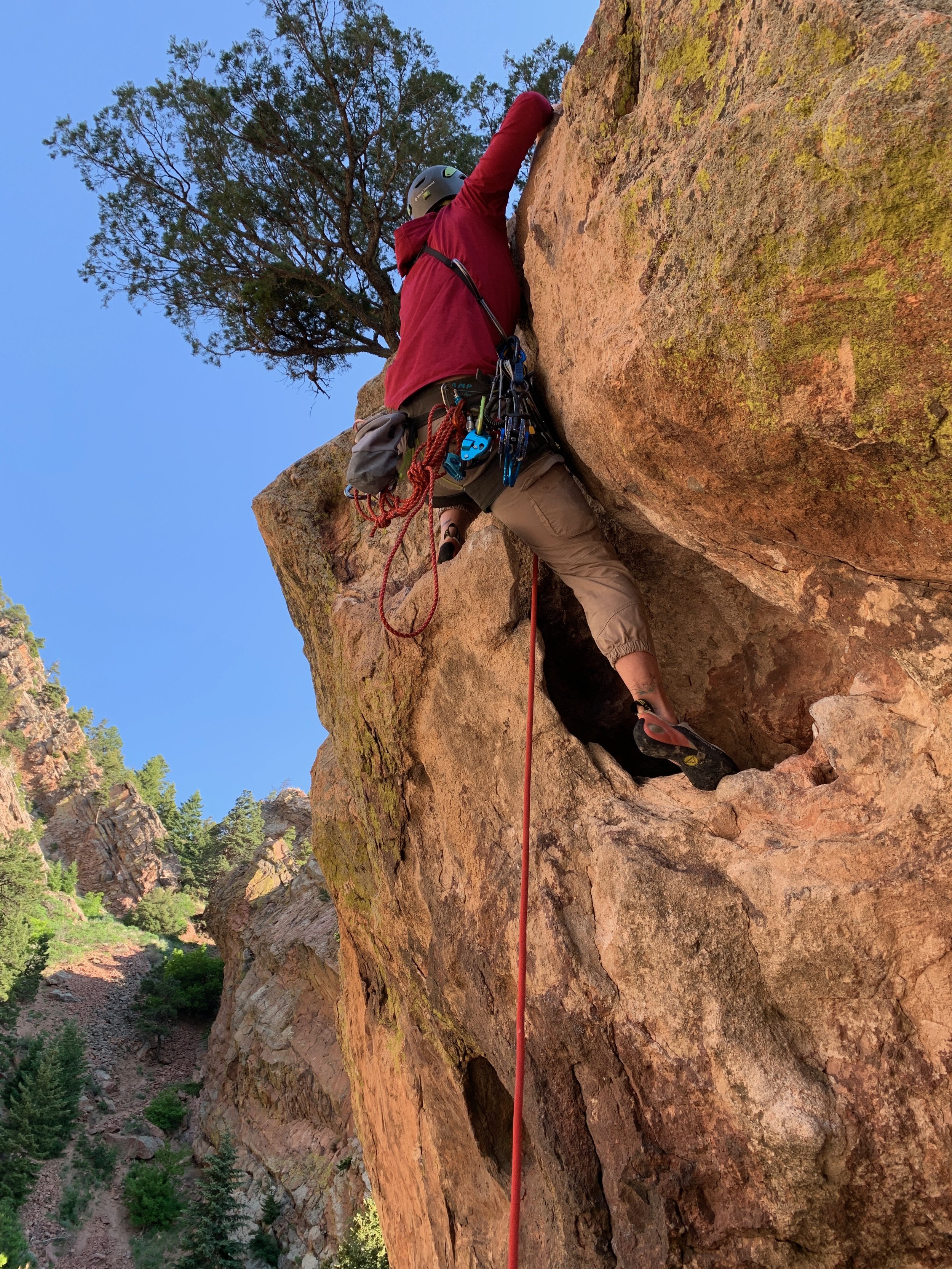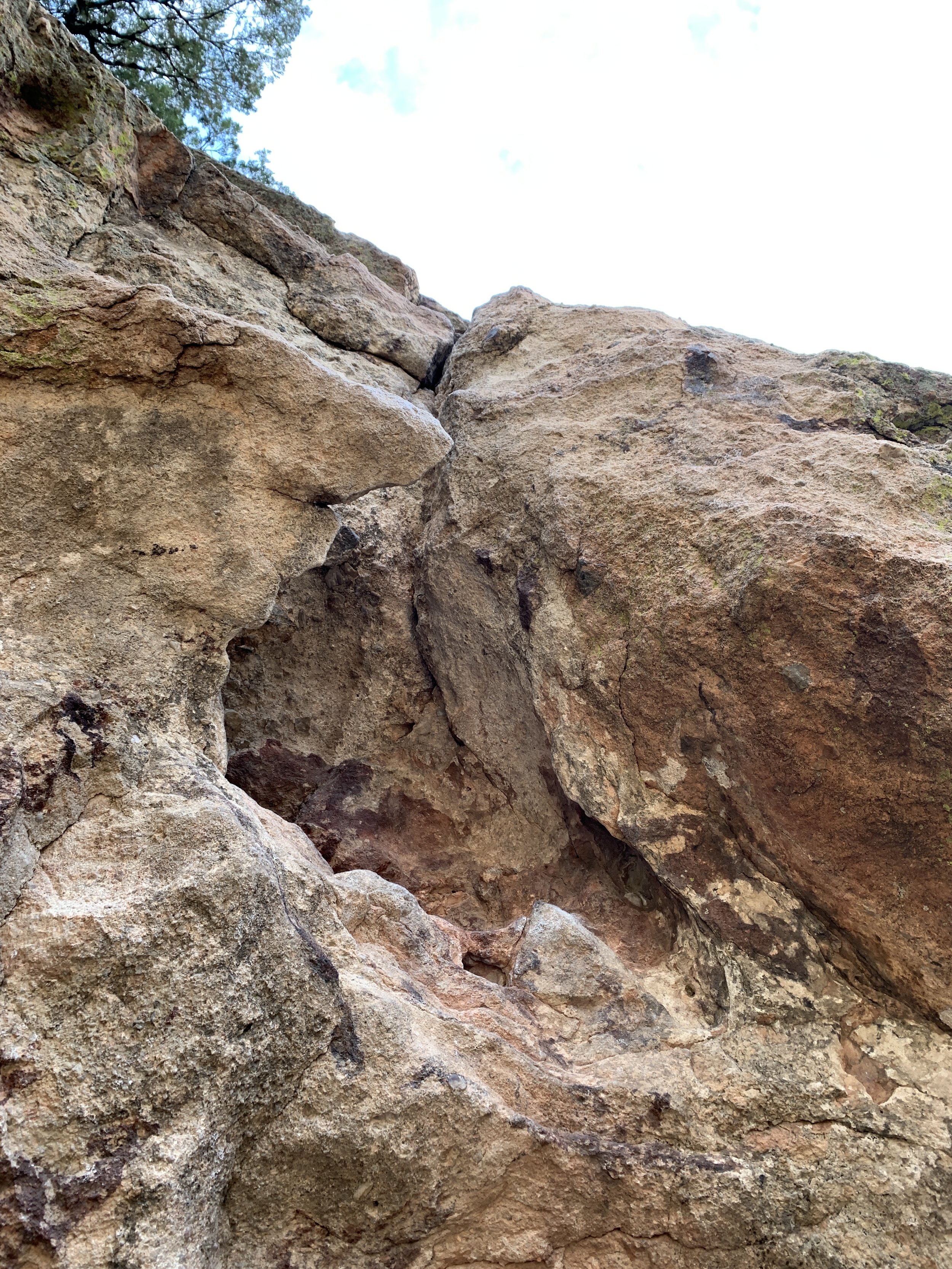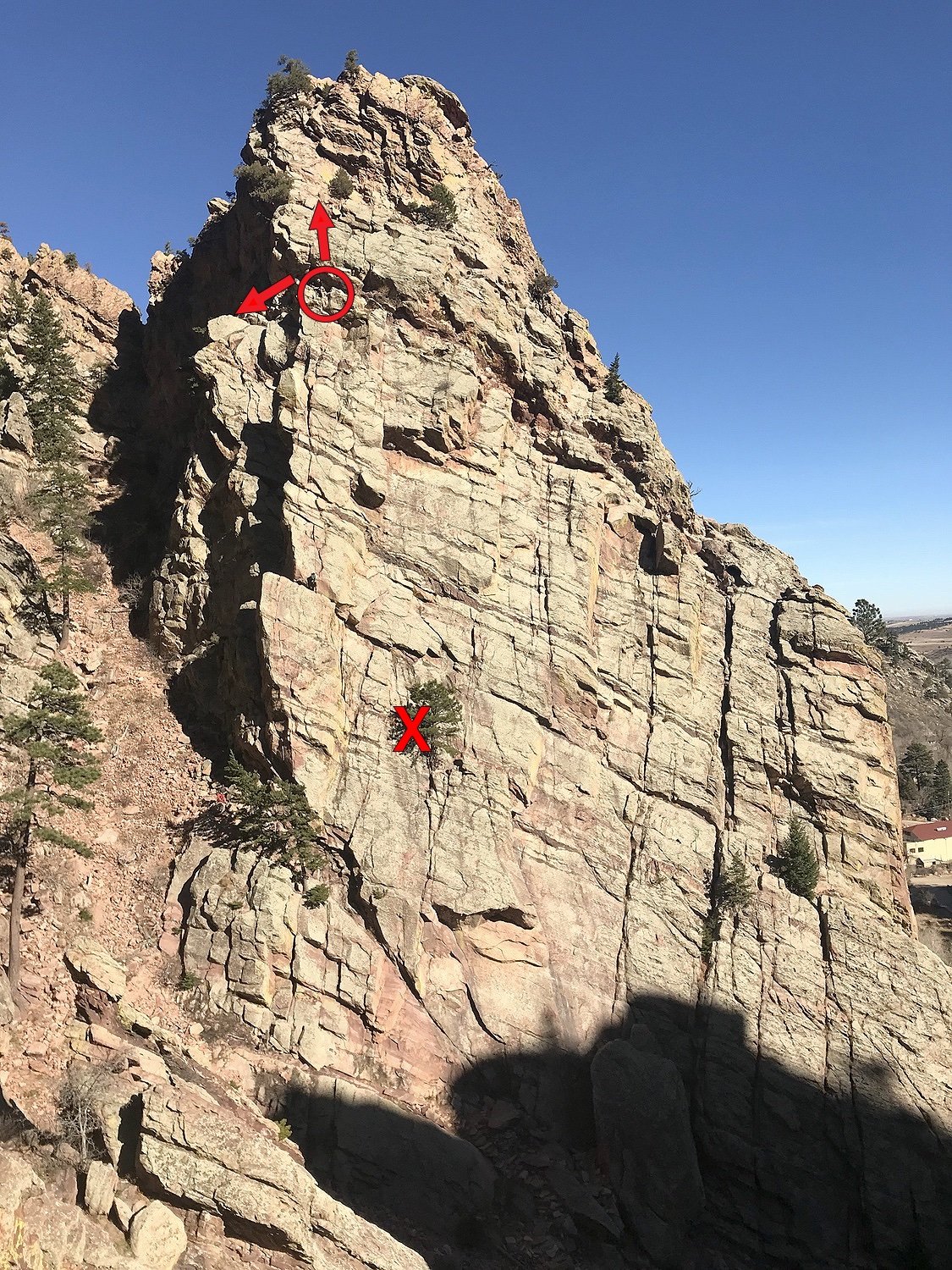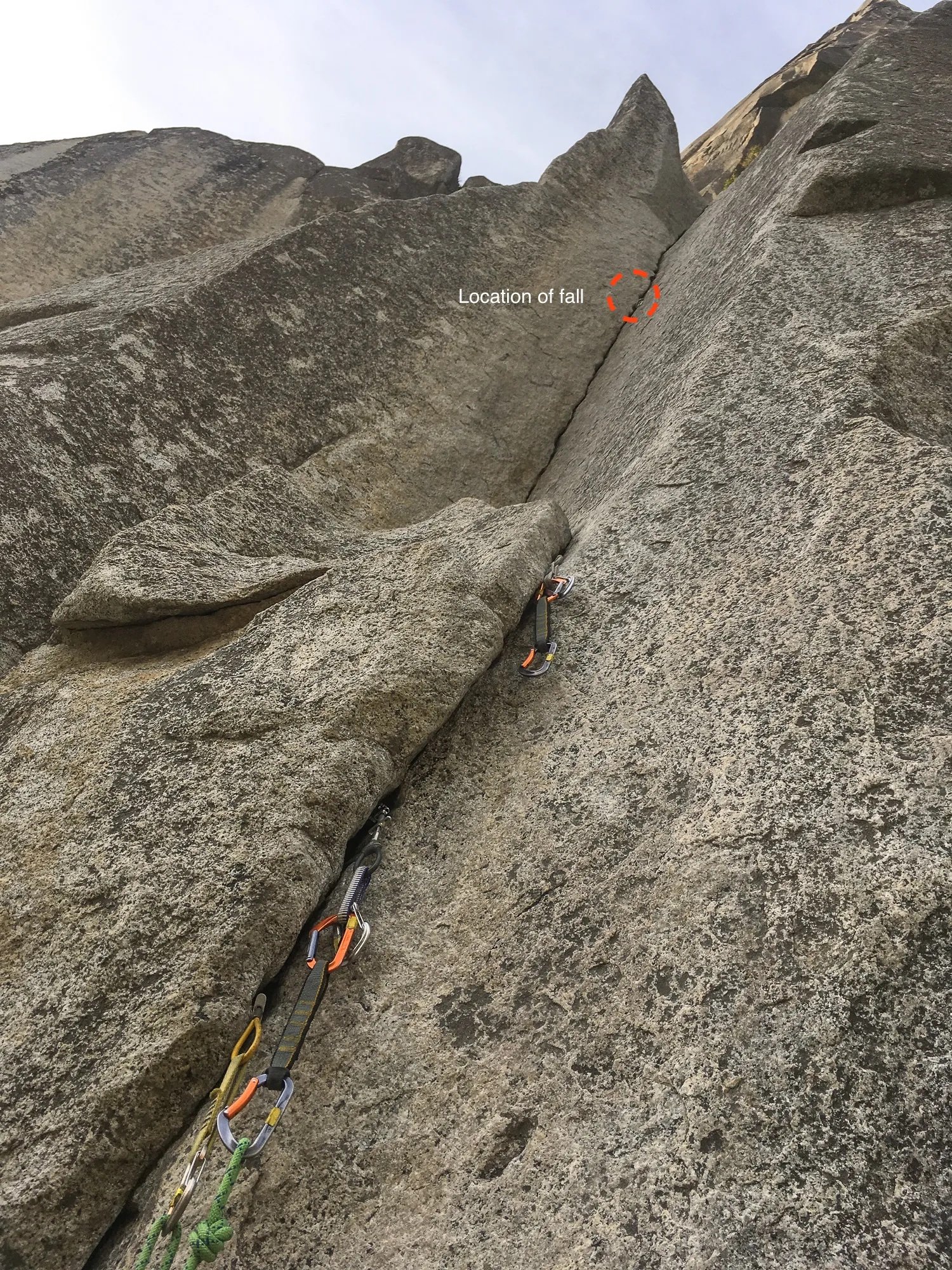The following reports will appear in the upcoming 2022 edition of Accidents in North American Climbing.
LEADER FALL | Single Piece Pulled Out
Eldorado Canyon State Park, Wind Tower
Tiffany Hauck just moments before slipping and falling 30 feet, directly past the belay. Photo: Mike Sutton
My partner Mike (46) and I, Tiffany Hauck (50), convened on the morning of June 13, 2021. Our sights were set on Wind Ridge (4 pitches, 5.7). We had climbed on the route a month earlier but ended up missing a good portion of the ridge. We wanted to bag the full climb.
We made good progress and were soon at the top of the second pitch, nested in a cave-like hollow. Mike had led the previous pitch and opted to wrap the rope around a single largish boulder as the only anchor in the belay. I’d led the next pitch previously and knew that once I maneuvered past the chin-up, it was gravy.
I tightened my helmet and stepped onto a nearby boulder, so I could stretch and reach a large flake, which overhangs about eight feet above the belay. I heaved myself up into a narrow hollow. I put a cam in the same crack I’d previously used and then yanked in four directions. Satisfied the cam was stable and wouldn’t walk, I clipped in, stood up, assessed my position, and made a step onto a tiny foothold—and I slipped.
My right side slammed onto a large boulder at the edge of the belay ledge and I bounced—how far out, I don’t know, as I lost sense of direction. [As Hauck fell, the sole cam she had placed as protection pulled out.] My ears filled with the sound of pro slamming into the rock and striking my helmet. I was yanked back toward the rock, then bounced briefly again before I came to a stop. [Hauck and her partner estimated the fall was around 30 feet, ending well below the belay ledge.]
Looking up at the narrow hollow crux, where two different falls in 2021 led to serious accidents. Photo: Tiffany Hauck
It took time, but I righted myself and looked up to see Mike leaning over the boulder I’d hit on the way down. The first thing I noticed was a large splatter of blood on the rock between us, but Mike quickly explained that it was his blood—he had been pulled violently across the rock when I fell. I painfully climbed back to the belay ledge, and eventually we scrambled over to the descent trail. With the help of Mike and a climber named Hillary, who had come up the route behind us, I was able to walk out under my own power.
A visit to the emergency room revealed no concussion and no broken bones. I had minor scrapes and bruises on my shins, and contusions on my hip and buttocks. That evening, my left shin swelled to twice its normal size. The contusion would take weeks to heal.
Analysis
It is hard to say for sure the cause of the cam failing. I don’t know if it’s because I put in the wrong sized cam or if I put it in a bad location. But the most likely cause is that I placed too small of a cam, or that I placed it in a flaring crack. (Source: Tiffany Hauck.)
The second-pitch belay anchor on Wind Ridge is best built with this large block, in this case using part of the lead rope to tie it off. The long sling in the foreground is clipped to a cam placed in a shallow pocket. Photo: Pete Takeda
Editor’s Note: On Wind Ridge, a fall at this point is often a ledge fall. The cracks available at this crux are flared and piton-scarred, making cam placements tricky. Often, cams placed straight into piton scars appear secure. However, when the cam is rotated downward under load, it can disengage. Also, the interior lobes, hidden from view, might not be securely engaged because of grooves inside the crack. One can easily choose to skip this pitch by traversing along the big ledge.
A TRAGIC ACCIDENT TWO MONTHS LATER
Wind Ridge climbs directly to the circled belay ledge atop pitch two. This was the site of both accidents reported here. At this point, climbers can either escape left or continue through an overhang. In the August 2021 incident, the two climbers fell all the way to the point marked X. Photo: Tommy Copeland
The exact spot of Hauck’s fall was the site of an eerily similar accident two months later. On August 26, two climbers suffered a belay anchor failure and fell over 100 feet. Climber 1 was in his 20s and survived with severe injuries. Climber 2 was in his 30s. He sustained fatal injuries.
In a Climbing magazine accident report, Climber 1 recalled using a cordelette to girth-hitch a horn in the alcove for a belay. Climber 1 began leading the third pitch and moved out of the narrow hollow (where Hauck had fallen), at which point he gave his belayer a warning and fell.
The two climbers tumbled end over end until they stopped on a ledge with a tree above the first pitch of a route called Tagger.
Later, SAR found no evidence of an anchor at the belay ledge. Perhaps the pair were unanchored. Perhaps their gear came unclipped or broke, as can happen in severe incidents. What is certain is their anchor, assuming they had one, was insufficient.
Danger Zones
Eldorado Canyon is notorious for its heady climbing style and demanding terrain. Adventure often extends well beyond the grade of the climbing and into the realm of rock quality, gear placements, and building belay anchors. See “DANGER ZONES: ELDORADO CANYON” for more information on where and why accidents happen in Colorado's trad mecca.
SAME ACCIDENT, ONLY DIFFERENT
On pitch two of the South Face of Washington Column, the leader fell 35 feet after a piece failed in a pin-scarred crack. Several of his lower pieces pulled as he fell. Photo: NPS
Piton scars infest many popular routes across North America. Back in the day, climbers hammered these tapered, nail-like spikes—often called “pins”—into cracks, using them as we now use nuts and cams. Over the years, repeated placement and removal of pitons marred these cracks with flared and irregular scars. Today, these disfigured cracks often offer passage on many moderate and popular classics. Thus, novices are often confronted with tricky protection placements.
California, Yosemite Valley
On October 7, 2016, two climbers started up the South Face of Washington Column. This popular route is a first big wall for many. On pitch two, the leader started climbing up a pin-scarred corner rated C1. Approximately 35 feet up, the piece he was standing on pulled out. The team believe that the falling leader pulled out an additional three pieces of gear during his fall, before landing on the belay ledge on his right side. When he tried to move, the injured leader experienced excruciating pain on his side and was having trouble breathing. They called 911 and YOSAR responded with an ultimately successful rescue. As with Hauck’s accident on Wind Ridge (above), the culprit was an inadequately placed cam in a piton scar. Read more on this in ANAC 2017.
See the National Park Service Accident Report for more images and details.
The Prescription newsletter is published monthly by the American Alpine Club.






